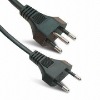Electricity in Brazil 220 Volt /127 Volt /50 Hz/60 HZ and a lot of plugs and connectors
We have received a lot of questions about the standards of electricity in Brazil. Brazil is the only country who are using the N-type plug and connectors. Brazil is standardizing on the below plugs. You will still find a lot of sockets based on the various old standards, but in every electricity store you will find adapters.
127 Volt or 230 Volt
Check the back of your appliance and look whether your appliance is suitable for the power voltage you are using at your place. Most European countries are using 230 Volt as a standards. If you have moved to a place where they are using 127 Volt you have to buy a converter/transformer first.
60 Hz
Please be aware the frequency is 60 Hz. However 50 Hz is the frequency most European appliance use. Some appliances will work, others simply will not work and there are appliances which are getting out of control.
Generally speaking appliances with pumps (Coffee-machines, washing machines etc.) which are only qualified for 50 Hz will simply NOT work. You can bring them to Brazil, however you have to change the pump. Appliances with motors will most of the time run about 20% faster, however the same appliances with electronic regulators may go on tilt. Your clock radio will most times work, but you will wake up an hour earlier.
In general it might be wise not to take electronics to Brazil. Sell it in your home country and buy new stuff here.
Below details are from www.worldstandards.eu
TYPE N |
||||||||||||||||||||||||||||||||||||||||||||||||||||||||||||||||||||||||||||||||||||||||||||||||||||||||||||||||
| (used exclusively in Brazil) | ||||||||||||||||||||||||||||||||||||||||||||||||||||||||||||||||||||||||||||||||||||||||||||||||||||||||||||||||
The above type N socket and plug are the official standard in Brazil. This standard was gradually phased in between 2007 and 2010. Type N looks very much like the Swiss type J standard, but it is incompatible with it since type N has the earth pin closer to the centre line than type J (3 mm instead of 5 mm). Type N consists of two pins and a grounding pin. There are two versions: one is rated at 10 amps and has got a pin diameter of 4 mm. The second version, rated at 20 amps, is used for heavier appliances and has a 4.8 mm pin diameter. Type N sockets were specifically designed to accommodate the ubiquitous type C plugs as well.Type N is actually based on the international standard 230 V household plug system, called IEC 60906-1. In 1986, the International Electrotechnical Commission published this standard, which was intended to become the common standard for the whole of Europe (and, by extension, all other regions with 230 V mains). Unfortunately, the effort to adopt it as a European Union standard was put on hold in the mid-1990s. Brazil had been using as many as 10 (!) different types of plugs and sockets, including the frequently used type C. In order to put an end to this proliferation of different types of sockets and plugs, the Brazilian Association of Technical Standards (Associação Brasileira de Normas Técnicas (ABNT)) published the standard NBR 14136 in 2001 and started implementing it in 2007. This Norma BRasileira 14136, however, is not completely identical to IEC 60906-1. The biggest difference is the fact that the Brazilian standard has a pin diameter of 4mm for the 10A plug and 4.8mm for the 20A plug, while the original IEC 60906-1 standard has a single pin diameter of 4.5mm and a maximum current of 16A.Although type N plug and socket are among the safest in the world, Brazil’s standardisation on one single plug and socket does entail some risks. Why? Simply because Brazil is one of the few countries that does not have a standard voltage, but at the same time it has only one official type of socket! In other words, you cannot tell the difference between a 220 V and a 127 V socket! (Click here for an exhaustive list of all 27 Brazilian federative units and their respective voltages.) Most states use 127 V electricity, but a couple of them are on 220 V. This means that a 127 V hairdryer bought in the state of Minas Gerais will be destroyed when plugged into a compatible 220 V socket in Distrito Federal! Make sure you check out the local voltage before plugging something in! It must be said, though, that many appliances sold in Brazil are dual voltage, but that’s definitely not the case for all of them.
|




